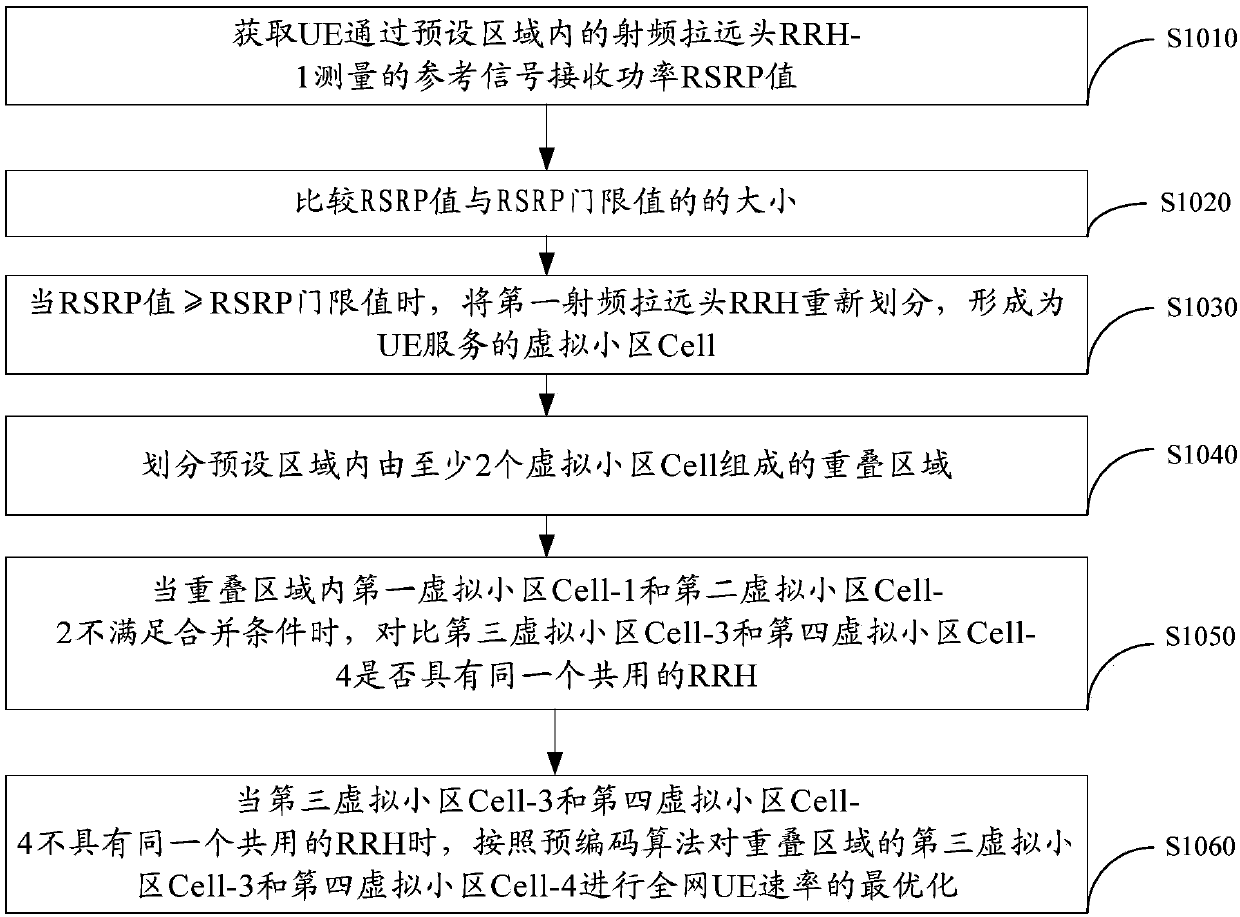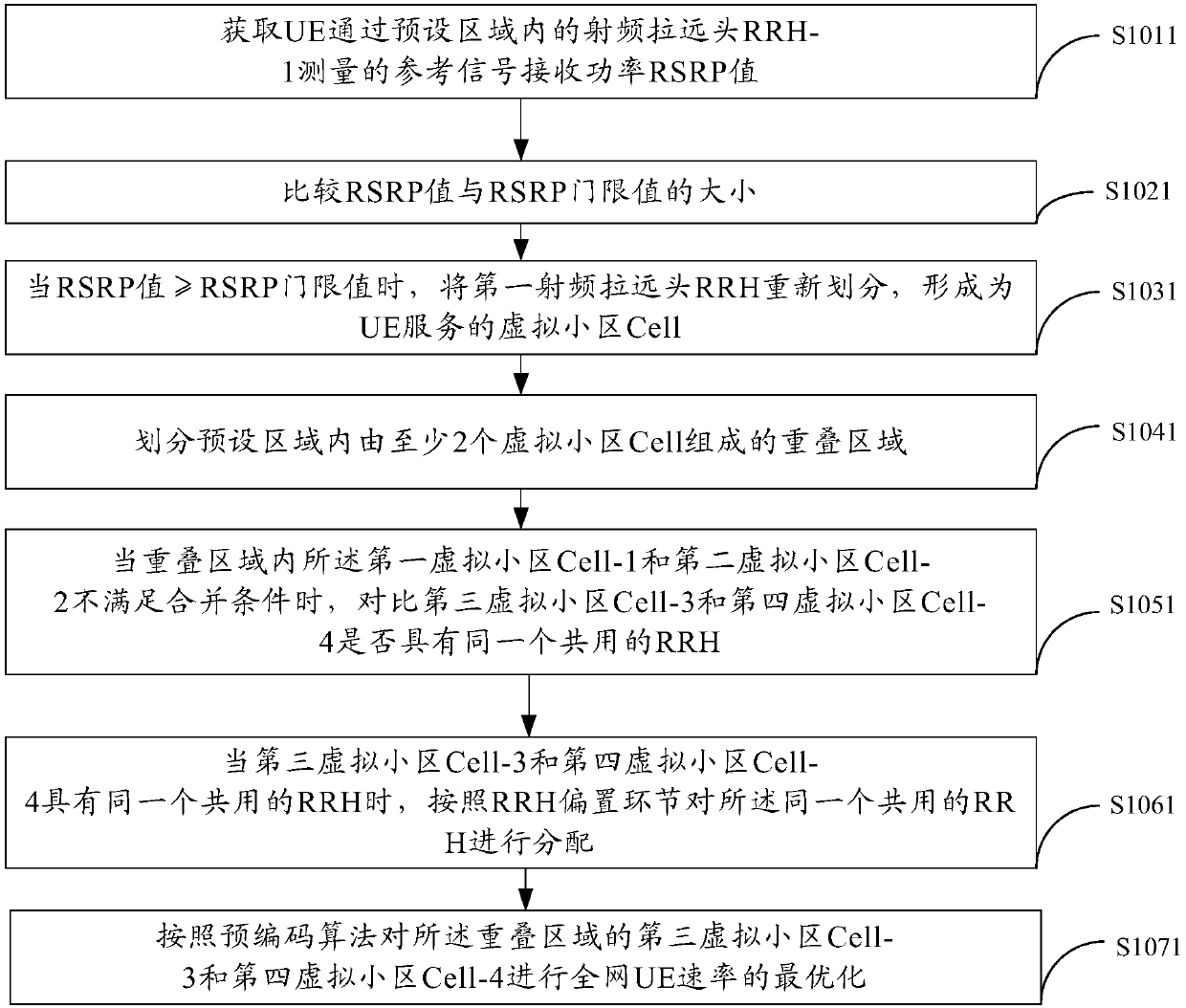Method and device for merging virtual cells and network system
A technology of virtual cell and area, applied in the field of network communication, which can solve the problems of low user rate, reduced RRH and user signal transmission rate, etc.
- Summary
- Abstract
- Description
- Claims
- Application Information
AI Technical Summary
Problems solved by technology
Method used
Image
Examples
Embodiment 1
[0104] Embodiment 1. The embodiment of the present invention provides a method for merging virtual cells, such as figure 1 Shown include:
[0105] S101. Divide an overlapping area composed of at least two virtual cells in a preset area.
[0106] S102. When the first virtual cell Cell-1 and the second virtual cell Cell-2 in the overlapping area meet the merging condition, merge the first virtual cell Cell-1 and the second virtual cell Cell-2 that meet the merging condition in the overlapping area into a new virtual community Mu-Cell.
[0107] Wherein, the first virtual cell Cell-1 and the second virtual cell Cell-2 respectively belong to one of at least two virtual cells Cell, and the first virtual cell Cell-1 and the second virtual cell Cell-2 are different, the first virtual cell The cell Cell-1 provides services for at least one first UE, the second virtual cell Cell-2 provides services for at least one second UE, and the new virtual cell Mu-Cell provides services for at l...
Embodiment 2
[0109] Embodiment 2. The embodiment of the present invention provides a method for merging virtual cells, such as Figure 2-a – Figure 2-d Shown include:
[0110] Scenario 1. Embodiments of the present invention provide a method for merging virtual cells, such as Figure 2-a Shown include:
[0111] S1010. Obtain the reference signal received power RSRP value measured by the UE through the remote radio head RRH-1 in the preset area, where the remote radio head RRH-1 is any remote radio head RRH in the preset area.
[0112] S1020. Compare the RSRP value with the RSRP threshold value.
[0113] It should be noted that the RSRP threshold value refers to the minimum RSRP set by the UE; for example, if the RSRP threshold value is -130dBm, and the RSRP value measured by the UE through RRH-a is -100dBm, the measured RSRP value at this time -100dBm is greater than the RSRP threshold value -130dBm, so this RRH-a can be used as the RRH that provides services for the UE; if the RSRP v...
Embodiment 3
[0193] Embodiment 3. Embodiments of the present invention provide an implementation of a virtual cell merging method in practical applications, such as Figure 3-a , Figure 3-b as well as Figure 4-a-Figure 4-e Shown include:
[0194] It should be noted that Embodiment 3 aims to provide a method for merging virtual cells to be applied under the same-frequency condition of ultra-dense C-RAN downlink multi-antenna RRH (the RRH in the embodiment uses 2 transmit antennas and the user has a single antenna). It solves the problem of converting the interference between virtual cells into multi-user interference in the virtual cell under the condition of unified frequency reuse, combined with the layered precoding algorithm, to improve the average user spectral efficiency and the user rate of the entire network.
[0195] Step S1, according to the RSRP threshold, an initial virtual cell centered on the user is formed.
[0196] It should be noted that, in actual application, step S1...
PUM
 Login to View More
Login to View More Abstract
Description
Claims
Application Information
 Login to View More
Login to View More - R&D
- Intellectual Property
- Life Sciences
- Materials
- Tech Scout
- Unparalleled Data Quality
- Higher Quality Content
- 60% Fewer Hallucinations
Browse by: Latest US Patents, China's latest patents, Technical Efficacy Thesaurus, Application Domain, Technology Topic, Popular Technical Reports.
© 2025 PatSnap. All rights reserved.Legal|Privacy policy|Modern Slavery Act Transparency Statement|Sitemap|About US| Contact US: help@patsnap.com



